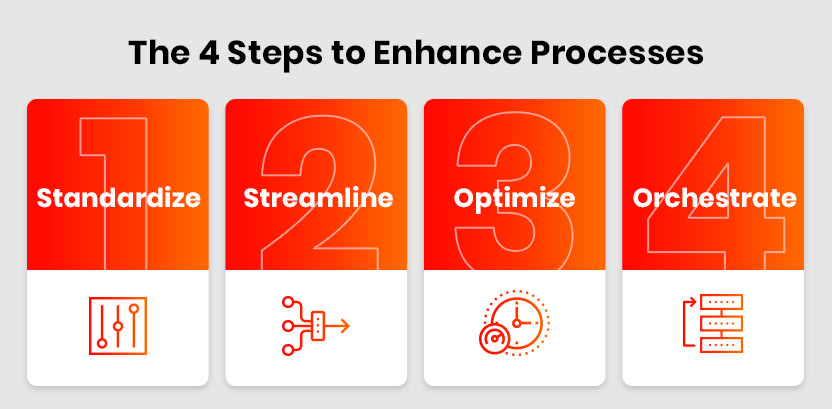
Behind the Hype: Why There’s More to Process Improvement than Hyperautomation
Mankind has always looked for ways to get rid of boring tasks. The goal: to achieve better outcomes in a shorter amount of time. We invented spears to hunt our food, washing machines to wash our laundry, and computers to solve complex problems faster than the world’s brightest mathematicians.
We went on to get rid of repetitive tasks at work, too. Robotic Process Automation (RPA) helped automate the kind of boring and repetitive task every employee hates: filling out forms, submitting travel expense reports, typing into excel sheets, ordering new office supplies. That way, people can spend more time doing higher-value work they actually like.
And yet, there’s one big problem. Executives aren’t actually seeing better outcomes. Fewer clicks in SAP doesn’t magically lead to higher revenue. Some forms filling themselves out automatically don't make customers happier. And companies have started to realize that.

That’s when Hyperautomation came into play. The term introduced by Gartner in its Top 10 Strategic Technology Trends has garnered huge interest across industries. It’s the idea that smarter automation solves all problems — by bringing technologies like AI or Machine Learning into the game. But there’s still one fundamental problem. As we’ve shown in the first part in our series on Hyperautomation, the tech trend is still more hype than reality. Simply put, it is based on the idea that automation — however multi-faceted — is the only solution to improve the way your business works. By focusing on the technology rather than the problem itself, we forget why we’re trying to solve the problem in the first place: to achieve better business outcomes.
If you want to deliver better outcomes, you need to enhance your underlying process. And when you’re enhancing processes, there is no one-size-fits-all solution.
Technologies like Machine Learning, AI, or RPA can certainly help you, but first and foremost, you need a holistic process improvement strategy.
In this article, we’ll share a framework that helps you to determine which process enhancement approach (and possibly which technology)will help you best to achieve the outcomes you want.

The Four Ways to Enhance a Process
1. Standardize your process Imagine if your car manufacturing staff had no set guidelines for building a car.
It would be like pulling in a group of people from the street, placing them at the assembly line and expecting them to build it.
Instead of a job well done, it’d probably look more like this:

There are literally a thousand ways a process can run and, of course, some ways will be more efficient than others. That’s why every task in a business process, regardless of how often you do it, requires a set of rules that define the scope, standard, and methods to be followed. Only by standardizing these rules will you have visibility over whether you’re ensuring quality and reducing human error.
If your desired outcome is improving compliance or reducing audit risk, standardization should be your number one priority. Get an objective, data-based perspective of your as-is process by discovering the key variants in your workflow. Remove variants with the help of actionable recommendations or team training and report on the improved compliance.
Why you should find the optimal path of your processes
Standardizing:
Improves clarity — because a standard process will eliminate the need for guesswork or extra searching for instructions.
Guarantees quality — because work is done in a pre-defined, optimized way.
Promotes productivity — because your employees won’t need to ask around or comb through documentation to get answers.
2. Streamline your processes Most process excellence projects start with the end goal of a faster or less costly process — effectively streamlining that process. If your desired business outcome is a faster throughput time or a reduced cost per step, then streamlining your process is what you’re after.
There are many ways to streamline your process: you can remove unnecessary steps (like a credit check on small orders or customers that have been financially reliable in the past), train people to avoid re-work, adjust workload balance to decrease bottlenecks, and yes, even automate manual steps. This is where automation is used most prevalently today — and can be a good way to achieve a more efficient outcome.
However, automation is still only one possible way to enhance the process to achieve increased efficiency. It generally results in reduced human effort and saves time. Those are good things, but they also need to be the outcomes you want. Either way, you will want to know where the best places to automate are — and Process Mining will help there.
Why you should remove waste from your process
Streamlining:
Removes bottlenecks — by finding the root causes for friction points in your process and removing them.
Avoids duplicate work — by redefining your process to have first-time-right results.
Reduces manual effort and boosts employee morale — by letting your employees focus on the tasks that really create value.
3. Optimize your process
Following a predefined set of rules will streamline and standardize your processes, but it will only take you so far. To achieve more than just a faster or more cost-efficient process, you’ll want to optimize your process for a specific outcome. This is where AI and machine learning software comes in. By giving you recommendations of next-best actions, the software helps you to identify and deploy the most effective proactive action that can help an organization meet the desired outcome.
You could compare it to Google Maps. The mapping software informs you about roadblocks and traffic jams in real time, so that you can make a decision on what will be the optimal route to your destination. AI-based software can see and analyze friction points in your processes in real time and helps you take the smartest possible decision at each step in the process — to maximize your desired process outcome.

For example, one of Top 10 manufacturers in the world identified $78M working capital impact in their Accounts Payable process, by predicting the optimal time to pay with next-best action recommendations. Whether you call that Hyperautomation or process optimization doesn’t really matter. The point is that you can take different paths in the process to optimize an outcome — and you may not need to deploy any automation at all to achieve it.
Why you should optimize your process
Optimizing:
Promotes productivity — because work is done in an optimized way.
Drives better outcomes — because it helps your employees decide which path to follow to maximize the business outcome.
Boosts employee morale — because they can see how they drive results.
Increases customer satisfaction — by resolving issues quickly and providing a customized experience.
Ensures regulatory compliance — by delivering context-sensitive instructions to your employee’s desktops.
4. Orchestrate your process
Once you’ve standardized, streamlined and optimized your processes, it’s time to have a look at the bigger picture. I’m talking about orchestration: How are your business processes impacting one another — and therefore your cross-departmental outcomes?
Even well-established companies routinely fail to manage their business operations across departmental silos. Although businesses increasingly aim for digitization and transparency, the ownership of processes and information flow between departments is still fragmented, and the internal complexity of processes hinders cross-business collaboration.

The result: interactions with customers are sluggish; complex, customized products are hard to create on time and on budget; and poor internal communication stops innovation and change across departments. In the worst case scenario, one department could feasibly undermine the all efforts of another department without ever knowing it.
Let’s have a look at how it can be improved. A rapidly expanding IT and services distributor was struggling with a decreased cash flow due to slower customer payments in the service and maintenance department, a trend that posed a significant threat to their growth strategy. When getting into Process Mining, they saw that their problem was a long time to invoice, caused by several bottlenecks upstream:
Since Maintenance or repair service orders had different models based on hours, milestones or contractual quota, the average time from delivery to first invoice took up to 26 days.
Many of the orders in the system were later canceled or rejected, due to failed credit checks in the service order process or lack of inventory visibility in Warehousing.
High-volume customers were still using non-automated ordering methods such as phone or fax, slowing down the time to invoice.
By orchestrating Order Management, Warehousing, and Accounts Receivable and solving the bottlenecks upstream, they were able to pursue their original goal and drive toward sustainable growth and success.
How you can achieve company-wide Process Excellence with Orchestration
Orchestrating:
Drives outcomes — because it enables departments working hand in hand towards shared business targets
Reduces risk with increased transparency — because it enables an end-to-end view of all processes and how they interact.
Breaks down departmental silos and promotes collaboration — because it brings different stakeholders together to work on a shared goal.
Spurs innovation — because people’s perspectives can shed light on process problems and deliver innovative solutions that satisfy everyone.
Think outcomes before technology
Technology enables change, progression, and continuous improvement — provided that business leaders know why they use it and what they want to achieve with it.
Companies that don’t take the time to define and focus on their desired business outcomes will find themselves struggling, even if a new technology claims to be your silver bullet.
That’s why businesses aiming for true Process Excellence should first decide what business outcomes they’re aiming for and then decide what process enhancement approach will drive that outcome in the optimal and fastest way. Once you’ve made that decision, the technology — or technologies — that will get you there should become obvious.
No hype needed.





